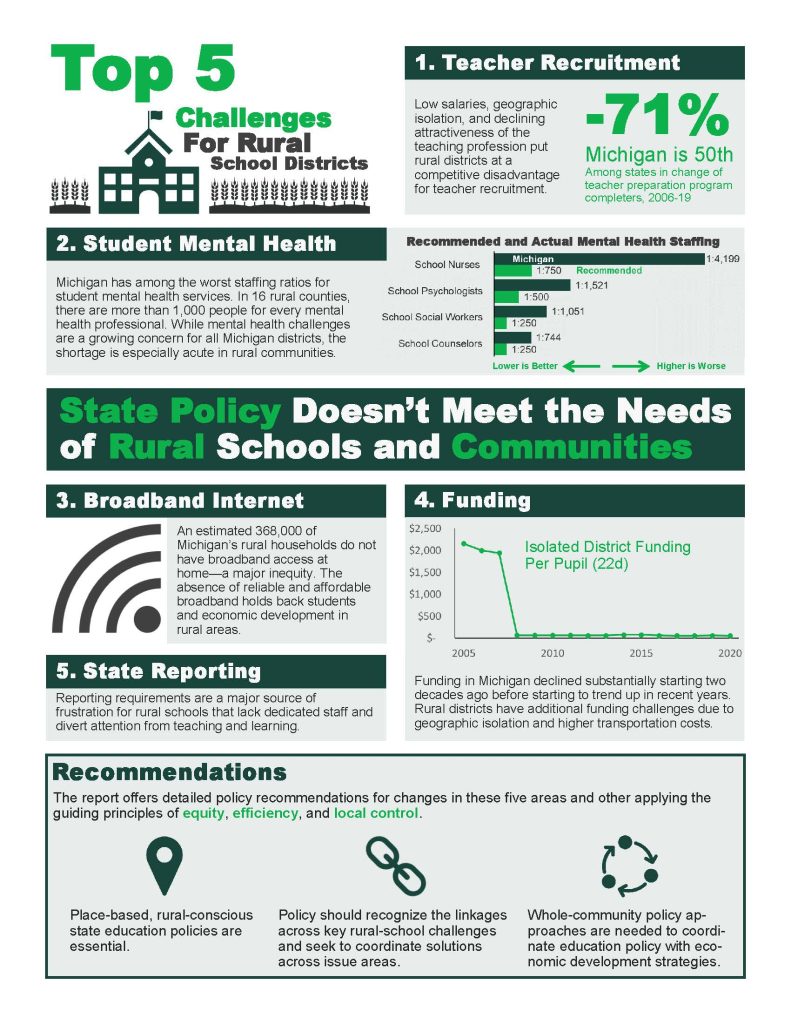David Arsen, Tanner Delpier, Annie Gensterblum, Rebecca Jacobsen, and Alexandra Stamm
Educational Opportunities and Community Development in Rural Michigan: A Roadmap For State Policy
Overview:
This report highlights key areas in which current state policies are failing Michigan’s rural schools and communities. Too often, current policies do not provide the opportunities we know are important for students to thrive as adults, while truncating community growth and development. To remedy these shortcomings, one-size-fits-all, statewide education policies will not suffice. Michigan must develop rural-conscious policies that give more attention to the specific circumstances and needs of rural students, families, and educators.
We present evidence on the many ways in which Michigan’s rural schools matter greatly for community life. They are very important as sites for sporting, cultural, and recreational activities. They are crucial settings in developing and enhancing social ties among local residents and are intricately tied to a community’s identity. Schools also serve as vital sites for civic engagement and democratic decision making.
Key Problem Areas:
- Teacher Recruitment and Retention
- Serving Students with Mental Health Needs
- Broadband Access
- Funding
- State Reporting Requirements


Context:
Profile of Michigan’s Rural Schools and Communities
Michigan’s rural school districts comprise over 88 percent of Michigan’s total land area, yet they enroll less than a third of the state’s K-12 students. Meanwhile rural school districts comprise roughly two-thirds of the state’s school districts.
On average, residents of Michigan’s rural communities are older, have lower levels of postsecondary educational attainment, and lower incomes than nonrural residents. Employment growth in rural Michigan lags far behind job growth in nonrural areas. Between 2011 and 2021, total employment increased by 7.3 percent in Michigan’s nonrural counties, but declined in rural counties.
Michigan’s rural communities are diverse on multiple dimensions. We present maps that depict this diversity across several measures, including family income, educational attainment, and elderly share of the population. In general, rural areas in the northwest Lower Peninsula and those nearest the state’s major metropolitan areas are more prosperous than other rural areas.
Methods:
This report is based on a three-year study. We collected and analyzed data for all Michigan rural schools and communities on a range of educational and socioeconomic measures. This quantitative evidence complements a much more intensive examination of 25 diverse and geographically representative Michigan rural school districts.
In each of these 25 districts we turned to the people who local citizens had selected to lead the education of their children, the local district superintendents, to help us understand the nature of the challenges their schools and communities face. We did not set out to test academic hypotheses, but rather took our bearings from what these community leaders told us about the factors that most limit opportunities for their students and communities.
Policy Options:
We offer three core propositions to inform rural education policy design. First, place-based, rural-conscious state education policies are essential. Universal state education policies will not suffice in meeting the challenges facing rural schools. Second, policy strategies should recognize the linkages across key rural-school challenges and seek to coordinate solutions across issue areas. And third, whole- community policy approaches are needed. Schools are inextricably linked with the economic and social well-being of rural communities. To succeed in areas with scarce extant resources, education policies should be integrated with community-development strategies.
Contact:
David Arsen, Ph.D., arsen@msu.edu





